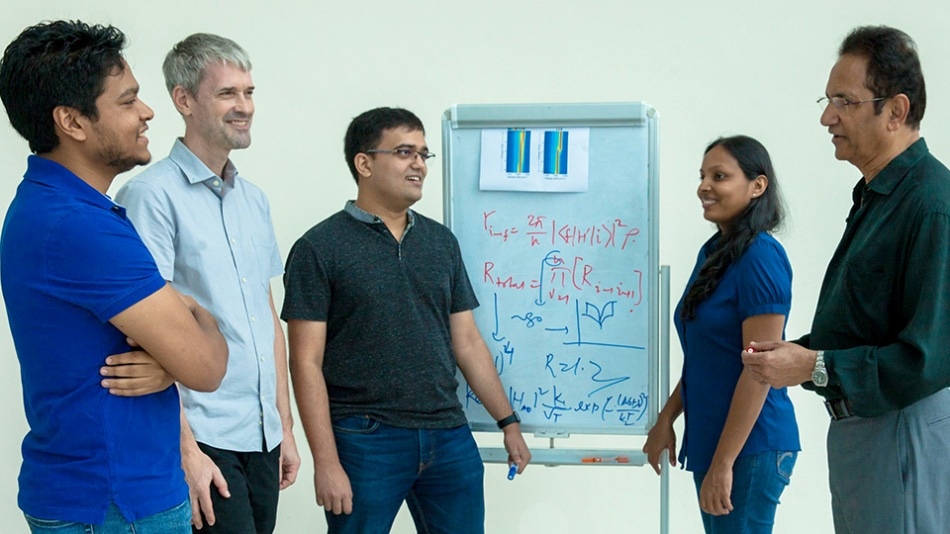Oct 25 2017
An international research team headed by Scientists from the National University of Singapore (NUS) were the very first to develop a novel thin, organic film capable of supporting a million more times read-write cycles and consuming 1,000 times less power than commercial flash memories.
 Researchers from NUS led the invention of a novel organic resistive memory device that is cheaper and has higher endurance as well as better energy efficiency than commercial flash memories. The overall coordinator for the project is Professor T Venky Venkatesan, Director of NUS Nanoscience and Nanotechnology Institute (extreme right).
Researchers from NUS led the invention of a novel organic resistive memory device that is cheaper and has higher endurance as well as better energy efficiency than commercial flash memories. The overall coordinator for the project is Professor T Venky Venkatesan, Director of NUS Nanoscience and Nanotechnology Institute (extreme right).
The novel organic film has the potential to store and process data for 1 trillion cycles and also has the ability to be made even smaller than its present size of 60 square nanometers, with potential to be sub-25 square nanometers.
The novel properties of our invention opens up a new field in the design and development of flexible and lightweight devices. Our work shifts the paradigm on how the industry has traditionally viewed organic electronics, and expands the application of such technologies into new territories.
Professor T Venky Venkatesan, Director of NUS Nanoscience and Nanotechnology Institute (NUSNNI)
The invention of this novel memory device was initially reported online in the journal Nature Materials on 23rd October 2017.
Global demand for improved electronic memory devices
With the beginning of the digital age, data is continuously produced and shared in devices ranging from industrial machines and mobile phones. Driven by this requirement for storing data, silicon-based flash memories have thus become ubiquitous.
For years, the computer industry has pursued to develop memory technologies with lower cost, greater endurance and better energy efficiency than commercial flash memories. The industry has restrained from using organic systems in memories because of their questionable claims of reproducibility, limitations in performance and the lack of scientific clarity on mechanisms via which they exhibit their behavior.
Mr Sreetosh Goswami, a Researcher from NUSNNI, addressed these challenges by successfully fabricating a novel organic resistive memory device capable of outperforming commercial flash memory in terms of endurance, cost and energy efficiency. He developed 600 working devices which demonstrated flawless reproducibility.
For the first time an organic device is looking industrially competitive. Also, we have developed a clear picture of the molecular mechanism based on our in-situ studies which organic devices have always been lacking.
Mr Sreetosh Goswami, a Researcher, NUSNNI
He is also a Graduate Student from the NUS School of Integrative Sciences and Engineering and is supervised by Professor Venkatesan.
The new device makes use of a transition metal complex which was designed and synthesized by Professor Sreebrata Goswami and his team, made up of Graduate Students Mr Santi Prasad Rath and Mr Debabrata Sengupta, from the Indian Association for Cultivation of Sciences.
We have been working on this unique family of metal complexes over the past few decades, to understand the chemical and physical properties which are controlled by ligand redox. Our understanding is now at a stage where we can engineer new materials by bring together different variations in the molecules, adding active functions and using right counter ions. This opens up new avenues to address many scientific problems.
Professor Sreebrata Goswami
To understand the science behind the device performance, Prof Venkatesan established a partnership with Professor Victor Batista from Yale University. Besides simulating the spectral behavior of the molecules, Dr Svante Hedstrom and Mr Adam Matula, who are from Prof Batista’s team, succeeded in identifying the role of the counter ions in the molecule which gave rise to a non-volatile memory behavior.
“The counter ions surrounding the molecules act like the ratchets on a wrench, and offer stability to the various electronic states of the molecule which are necessary to achieve the memory effect. This molecular-level understanding that we have helped to generate is unprecedented in a memory device, and allow us to create design principles for the next generation of devices,” commented Prof Batista.
Pushing the frontiers of memory technologies
The research team is aiming to create a partnership with a consumer electronics company in order to commercialize the new technology. The Researchers are also focusing on fabricating multi-state memories to develop neuromorphic memory devices (that look like the brain) for artificial intelligence (AI) applications, considered to be one of the fastest growing technology fields today.
Prof Venkatesan added, “AI relies on neuromorphic computing to simulate the architecture of the human brain. Therefore, the development of neuromorphic memory devices that can embody the concept of learning endemic to biological memory is crucial. Given the success of our current work, I believe we are on the right track to fabricate innovative memories which will have more than two states while maintaining all the fascinating properties of the device we currently have.”